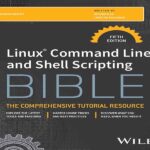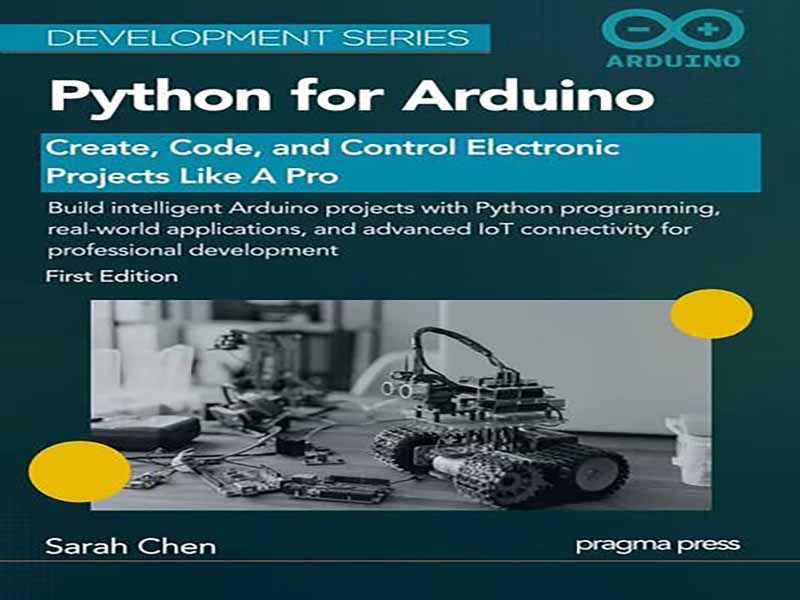- عنوان کتاب: Python for Arduino -Create, Code, and Control Electronic Projects Like A Pro
- نویسنده: Sarah Chen
- حوزه: برنامه نویسی Arduino
- سال انتشار: 2025
- تعداد صفحه: 536
- زبان اصلی: انگلیسی
- نوع فایل: pdf
- حجم فایل: 1.42 مگابایت
به «پایتون برای آردوینو: ایجاد، کدنویسی و کنترل پروژههای الکترونیکی مانند یک حرفهای» خوش آمدید. این کتاب اوج سالها تجربه در پر کردن شکاف بین برنامهنویسی سطح بالا و توسعه سختافزار تعبیهشده را نشان میدهد. ترکیب کتابخانههای قدرتمند پایتون و پلتفرم سختافزاری قابل دسترس آردوینو، دنیایی از امکانات را برای سازندگان، مهندسان و نوآوران میگشاید. این کتاب برای مخاطبان متنوعی از زبانآموزان و سازندگان طراحی شده است: توسعهدهندگان پایتون که میخواهند به برنامهنویسی سختافزار و محاسبات فیزیکی گسترش یابند. اگر با پایتون راحت هستید اما هرگز با میکروکنترلرها کار نکردهاید، این کتاب شما را در اصول سختافزار راهنمایی میکند و در عین حال از دانش برنامهنویسی موجود شما بهره میبرد. علاقهمندان به آردوینو که پروژههای ابتدایی ساختهاند اما میخواهند قابلیتهای پیشرفتهای مانند تجزیه و تحلیل دادهها، یادگیری ماشین و رابطهای کاربری پیچیده را آزاد کنند. تجربه سختافزاری شما همراه با قدرت محاسباتی پایتون، پروژههای شما را به سطح بالاتری میبرد. مبتدیان کامل با دانش برنامهنویسی پایه که مشتاق یادگیری پایتون و آردوینو از یک رویکرد عملی و مبتنی بر پروژه هستند. در حالی که مقداری پیشزمینه برنامهنویسی مفید است، این کتاب شامل مفاهیم ضروری پایتون مورد نیاز برای ادغام آردوینو است. دانشجویان و مدرسان علوم کامپیوتر، مهندسی برق یا رشتههای مرتبط که نیاز به پوشش جامعی از ادغام سختافزار-نرمافزار با مثالهای عملی و کاربردهای دنیای واقعی دارند. مهندسان و سازندگان حرفهای که روی پروژههای اینترنت اشیا، سیستمهای اتوماسیون یا نمونهسازی اولیه کار میکنند و نیاز به ترکیب قابلیتهای بلادرنگ آردوینو با اکوسیستم غنی کتابخانههای پایتون دارند. علاقهمندان و علاقهمندان به DIY که میخواهند سیستمهای خانه هوشمند، پروژههای رباتیک یا دستگاههای جمعآوری داده با قابلیتهای حرفهای ایجاد کنند. این راهنمای جامع شما را در دوازده فصل با دقت تدوینشده، به سفری ساختاریافته میبرد: مبانی (فصلهای ۱-۳): شما با درک آنچه آردوینو و پایتون را به چنین ترکیب قدرتمندی تبدیل میکند، راهاندازی محیط توسعه خود و تسلط بر مفاهیم ضروری آردوینو شروع خواهید کرد. ما اصول اولیه پایتون را که به طور خاص مربوط به برنامهنویسی سختافزار است، پوشش میدهیم و اطمینان حاصل میکنیم که پایه و اساس لازم را دارید. ارتباطات و پروژههای پایه (فصلهای ۴-۵): یاد بگیرید که چگونه ارتباط سریال قوی بین آردوینو و پایتون برقرار کنید، سپس این مهارتها را در پروژههای عملی از جمله کنترل LED، سنجش دما، موتورهای سروو و نمایشگرهای LCD به کار ببرید. مدیریت و مصورسازی دادهها (فصل 6): کشف کنید که چگونه دادههای خام حسگر را با استفاده از کتابخانههای مصورسازی قدرتمند پایتون، از جمله ترسیم بلادرنگ و داشبوردهای چند حسگری، به بینشهای معنادار تبدیل کنید. اینترنت اشیا و اتصال (فصل 7): با ایجاد سرورهای وب، ارسال دادهها به پلتفرمهای ابری و ساخت رابطهای کنترل از راه دور برای پروژههای آردوینو خود، وارد دنیای اینترنت اشیا شوید. ادغام یادگیری ماشین (فصل 8): با جمعآوری دادههای آموزشی، ساخت مدلها در پایتون و پیادهسازی رفتارهای هوشمند در آردوینو، تقاطع پیشرفته هوش مصنوعی و سیستمهای تعبیهشده را بررسی کنید. کاربردهای پیشرفته (فصل 9): پروژههای پیچیده از جمله سیستمهای اتوماسیون خانگی، ایستگاههای هواشناسی با تجزیه و تحلیل پیشرفته، رباتیک کنترلشده با بینایی کامپیوتر و کنترلکنندههای بازی سفارشی را مدیریت کنید. توسعه حرفهای (فصلهای 10-12): تکنیکهای اشکالزدایی، استراتژیهای بهینهسازی را بیاموزید و مسیرهای آینده از جمله حسگرهای پیشرفته، هوش مصنوعی روی میکروکنترلرها و ادغام با سایر پلتفرمها را بررسی کنید.
Welcome to “Python for Arduino: Create, Code, and Control Electronic Projects Like A Pro.” This book represents the culmination of years of experience in bridging the gap between high-level programming and embedded hardware development. The combination of Python’s powerful libraries and Arduino’s accessible hardware platform opens up a world of possibilities for creators, engineers, and innovators. This book is designed for a diverse audience of learners and makers: Python Developers who want to expand into hardware programming and physical computing. If you’re comfortable with Python but have never worked with microcontrollers, this book will guide you through the hardware fundamentals while leveraging your existing programming knowledge. Arduino Enthusiasts who have built basic projects but want to unlock advanced capabilities like data analysis, machine learning, and sophisticated user interfaces. Your hardware experience combined with Python’s computational power will take your projects to the next level. Complete Beginners with basic programming knowledge who are eager to learn both Python and Arduino from a practical, project-based approach. While some programming background is helpful, the book includes essential Python concepts needed for Arduino integration. Students and Educators in computer science, electrical engineering, or related fields who need comprehensive coverage of hardware-software integration with hands-on examples and real-world applications. Professional Engineers and Makers working on IoT projects, automation systems, or prototyping who need to combine Arduino’s real-time capabilities with Python’s rich ecosystem of libraries. Hobbyists and DIY Enthusiasts who want to create smart home systems, robotics projects, or data collection devices with professional-grade capabilities. This comprehensive guide takes you on a structured journey through twelve carefully crafted chapters: Foundations (Chapters 1-3): You’ll start by understanding what makes Arduino and Python such a powerful combination, setting up your development environment, and mastering essential Arduino concepts. We cover Python basics specifically relevant to hardware programming, ensuring you have the necessary foundation. Communication and Basic Projects (Chapters 4-5): Learn how to establish robust serial communication between Arduino and Python, then apply these skills to practical projects including LED control, temperature sensing, servo motors, and LCD displays. Data Handling and Visualization (Chapter 6): Discover how to transform raw sensor data into meaningful insights using Python’s powerful visualization libraries, including real-time plotting and multi-sensor dashboards. IoT and Connectivity (Chapter 7): Step into the Internet of Things world by creating web servers, sending data to cloud platforms, and building remote control interfaces for your Arduino projects. Machine Learning Integration (Chapter 8): Explore the cutting-edge intersection of AI and embedded systems by collecting training data, building models in Python, and implementing intelligent behaviors on Arduino. Advanced Applications (Chapter 9): Tackle sophisticated projects including home automation systems, weather stations with advanced analytics, computer vision-controlled robotics, and custom game controllers. Professional Development (Chapters 10-12): Master debugging techniques, optimization strategies, and explore future directions including advanced sensors, AI on microcontrollers, and integration with other platforms.
این کتاب را میتوانید از لینک زیر بصورت رایگان دانلود کنید:
Download: Python for Arduino



































نظرات کاربران